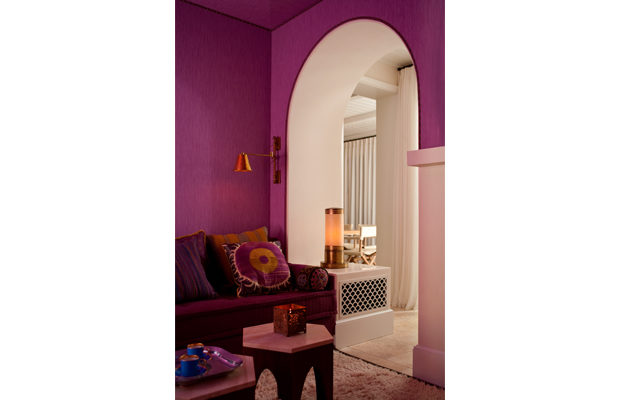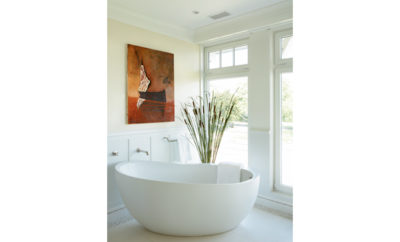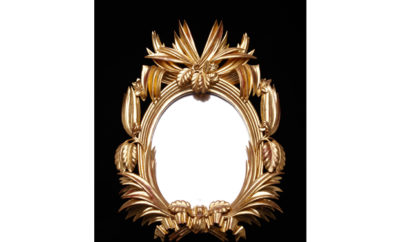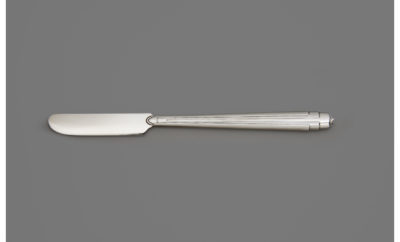
Feature
Marrakech, Long Island

The lively berry-colored living room features banquettes, pillows, and distressed-wood window grilles designed by DD Allen and Michael Pierce. The cylindrical lights were purchased in Morocco and wired for electricity. The decor also includes a set of six walnut side tables with hexagonal travertine marble tops designed by Harvey Probber in the 1950s.
Marrakech, Long Island
In a seaside community, architect Michael Pierce and interior designer DD Allen devised and furnished a house where modernism and exoticism get along superbly. Had he lived in a certain village on Long Island, the non-narrator character in Robert Frost’s famed poem “Mending Wall” might have said: “Good fenestration makes good neighbors.”
The hamlet—occupying one tip of an Atlantic coast barrier island just beyond the New York City line—is a tightly-knit community in multiple senses. One: the place has been a summer or year-round home to serial generations of families. Two: a majority of the houses there sit cheek-by-jowl, the structures taking up the full measure of the building lots on which they stand. “In many cases,” says architect Michael Pierce, co-principal of the Manhattan-based architecture and interior design firm Pierce Allen, “neighbors walking by or living across the street can stare straight into your living room.”
That helps explain the design decisions Pierce made when he and his business partner, DD Allen, were commissioned to create a new residence—inside and out. The street-side facade is strict enough (more or less) to satisfy even Adolph Loos, the turn-of–the-twentieth-century Austro-Hungarian architect best known for his manifesto “Ornament and Crime.” The front wall is bereft of all but two staggered windows, which open onto a stairway. The two non-Loosian details are a high-relief scallop-shell element surrounding a small econd-floor porthole window, which brings light into the guest bathroom and is too high to be seen through by prying eyes (it is an aspect of the “maritime motif” Pierce says he sought to attain), and a front door painted electric pink. The latter, Allen freely acknowledges, was a whim on the part of the female client—“it’s a girly thing.”
But the client specified more than privacy and a lipstick-livid entry. She had requested a Moroccan-themed house, so before the project began the trio set off to that North African country to find inspiration and furnishings. Once there, it quickly became apparent that their notions of the land might have been a bit romanticized, and that a total Moroccan architecture-and-decor scheme might be a bit over the top for modern living in New York. “We settled on something that would have a more Mediterranean vibe,” Pierce says.
But they did bring home scads of finds, including lamps, bits of carved grillwork, an antique unfinished-wood door with scalloped spandrels—later used as the entry to a powder room—and many, many rugs. These were so inexpensive—$60 to $80 each, says Pierce—that one of them was laid on the pergola-covered roof deck. A rich blue that covers the walls at the famed Majorelle Garden in Marrakech —restored by the late Yves Saint Laurent and his partner Pierre Bergé—was appropriated and used to paint the door that leads to the swimming pool area on the property.
The completed decor is a striking hybrid of the modern and the exotic. Most of the public spaces are bright and airy. The sitting room is pure mid-century in style, featuring such elements as a curving Dunbar sofa, a Warren Platner-designed ottoman, and a Belgian floor lamp with a stand made of beaded glass. A set of Jean-Michel Frank-designed X-base chairs in cerused oak surround a table of the same material designed by Pierce Allen. These pieces stand on an elegant green 1940s French rug with North African motifs, found in New York. “When we saw it, we had to have it,” Allen says.
The client did get her piece of the Near East in the living room. Despite the fuchsia-painted walls, the space is darker than other areas of the house. The windows are covered in wooden grilles, there are Moroccan oil lamps refitted for electricity, deep sofas strewn with a dozen pillows made with hand-dyed fabrics, and clusters of side tables with hexagonal stone tops and arched bases reminiscent of Moorish design. “It’s a cocoon at the very center of the floor plan,” Pierce says. “It has warmth.” And it is a place that brings to mind the customary greeting in the Arabic world: salaam—“Peace.”












